一谈到五种基本句型100例句 是大家最关心的。那么,就有必要说一下了,英语五种基本句型例句带翻译并指出对应的是什么.和五大基本句型 各20例句 ·五种基本句型100例句 的内容,好让您知道英语五种基本句型例句带翻译并指出对应的是什么,一起来看看吧。
五种基本句型100例句 :五大基本句型 各20例句 ·
英语的五种基本句型有:
主语+谓语(不及物动词) [S + V]
例句:(1)The children are playing happily. 孩子们正在高兴地玩。
(2)Everybody laughed. 大家都笑了。
(3)He stands. 他站着。
(4)He swims. 他游泳。
(5)She sings. 她唱歌。
(6)The student studies. 学生学习。
(7)We arrived. 我们到了。
(8)Time flies. 时光飞逝。
(9)The moon rose. 月亮升起。
(10)The man eat. 那个男人在吃饭。
(11)We all laughed. 我们都笑了。
(12)Everybody talked. 所有人都在讲话。
(13)I laughed. 我笑了。
(14)They cooked. 他们在做饭。
(15)She left.她离开了。
(16)He came.他来了。
(17)She cried.她哭了。
(18)The boy smiled.男孩笑了。
(19)The man died.那个人过世了。
(20)The sun rises.太阳升起来了。
2. 主语+谓语(及物动词)+宾语 [S+V+O]
例句:(1)The Greens enjoy living in China. 格林一家喜欢住在中国。
(2)I love apples.我喜欢苹果。
(3)I played the piano. 我弹钢琴。
(4)I like you.我喜欢你。
(5)I hate you. 我讨厌你。
(6)He need a piece of bread. 他需要一片面包。
(7)The monkey eats an banana. 那猴子吃了个香蕉。
(8)She opens the door. 她打开门。
(9)Lucy rides a blue bike. 露西骑一辆蓝色自行车。
(10)The man lands a job. 那男的找到一份工作。
(11)The teacher loses a chance. 这老师失去了一个机会。
(12)She moves that red box. 她移开那个红色箱子。
(13)I miss you. 我想你。
(14)He posted the latter.他把信寄出去了。
(15)Who knows the answer? 谁知道答案?
(16)She laughed at her. 她嘲笑他。
(17)He understands English. 他知道英语。
(18)He made cakes. 他做蛋糕。
(19)They ate apples. 他们吃苹果。
(20)He said "hi". 他说你好。
3. 主语+谓语+表语 [S+V+P]
该句型谓语动词为连系动词.常见的系动词有:be(是); get(变得), become(成为), turn(变得), look(看起来), feel(感到), smell(闻起来), taste(尝起来), sound(听起来), seem(似乎) 等。
例句:(1)He became a famous doctor. 他成为了一名著名的医生。
(2) The apple pie tastes really delicious. 苹果派吃起来真是好吃。
(3)His eyes are blue.他的眼睛是蓝色的。
(4)I am a student. 我是一个学生。
(5)He is a teather. 他是一个老师。
(6)Nothing is impossible. 没有什么是不可能的。
(7)You are beautiful. 你很漂亮。
(8)They are my friends. 他们是我的朋友。
(9)This is my family. 这是我家人。
(10)He is my father. 他是我爸。
(11)This is my favorite place. 这是我最喜欢的地方。
(12)That is my house. 那是我的房子。
(13)Mary is beautiful and smart. 玛丽很漂亮很聪明。
(14)This is a book. 这是一本书。
(15)The dinner smells good. 晚饭闻起来很好。
(16)He fell happy. 他觉得开心。
(17)Everything looks different. 所有事情都看起来不一样了。
(18)The book is interesting. 书很有趣。
(19)The weather became warmer. 天气转暖了。
(20)His face turned red. 他的脸变红了。
4. 主语+谓语+间接宾语+直接宾语 [S+V+InO+DO]
这种句型中的及物动词后跟双宾语,既指人的间接宾语和指物的直接宾语.也可以把间接宾语放在直接宾语之后,但要加介词for或to。
例句:(1)My aunt bought me a computer. 我阿姨买给我一台电脑。
(2) I passed him the salt. 我把盐递给他。
(3)I gave him my address.我告诉他我的地址。
(4)He gave me an apple. 他给了我一个苹果。
(5)My mother bought me a new schoolbag yesterday. 妈妈昨天给我买了一个新书包。
(6)I sent her a letter last week. 上周我给她发了一封信。
(7)The sun gives us light and warmth. 太阳给我们光和热。
(8)We sent him a telegram. 我们给他发了个电报。
(9)Mum bought my sister a present. 妈妈给我妹妹买了一份礼物。
(10)I can buy you some flowers. 我可以给你买一些花。
(11)You must bring me something to eat. 你一定要给我带一些吃的东西来。
(12)He bought me a book. 他给我买了一本书。
(13)He sent me an E-mail. 他给我寄了一封电子邮件。
(14)I told her a story. 我给她讲了一个故事。
(15)She writes me a letter every day. 他每天都给我写一封信。
(16)Chatting online will bring you a lot of fun. 网上聊天会给你带来很多乐趣。
(17)He lent me ten yuan. 他借给我10块钱。
(18)I will buy you a meal. 我会请你吃顿饭。
(19)I gave him my book. 我把我的书给他了。
(20)He showed the guard his passport. 他把通行证给门卫看了。
5. 主语+谓语+宾语+宾语补足语 [S+V+O+OC]
例句:(1)We must keep our school clean. 我们必须保持我们的学校清洁。
(2)I found the box empty. 我发现盒子是空的。
(3)I find the clock broken. 我看到钟表坏了。
(4)I saw him playing football. 我看到他在踢足球。
(5)They made the boy work 16 hours a day. 他们让这个男孩每天工作16小时。
(6)They ask us to work hard. 他们让我们努力工作。
(7)We made him monitor. 我们让他做班长。
(8)He asked me to clean the classroom. 他让我打扫教室。
(9)I asked him to have dinner. 我让他吃晚饭。
(10)He told me to clean the room. 他告诉我打扫房间。
(11) Tom wanted me to meet him. 汤姆想让我见他。
(12)I watch the boy playing foot ball. 我看到那个男孩在踢足球。
(13) My good friend told me a story. 我的好朋友给我讲了一个故事。
(14) LiLi noticed two dogs fight. 李利注意到两个狗在打架。
(15)Please hand me the paper. 请递给我一张纸。
(16)The lion ordered the hen to give him some eggs. 那头狮子命令那只母鸡给他一些鸡蛋。
(17)He wanted you to go with him. 他要你一起跟他去。
(18)Li Yang told the little boy to go home. 李扬叫那个小男孩回家。
(19)She asks me to help her. 她请我去帮助她。
(20)Mom let me in. 妈妈让我进去。
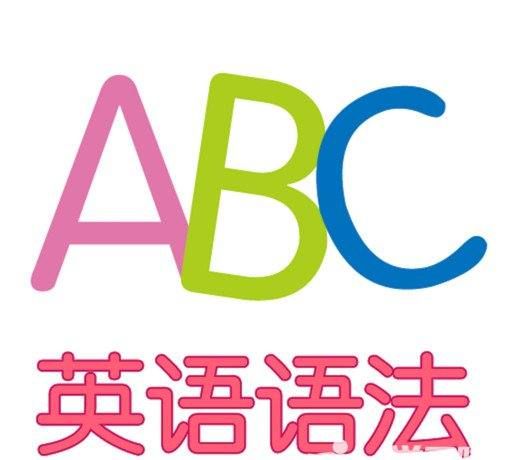
扩展资料:
英语语法是针对英语语言进行研究后,英语语法系统地总结归纳出来的一系列语言规则。英语语法的精髓在于掌握语言的使用。
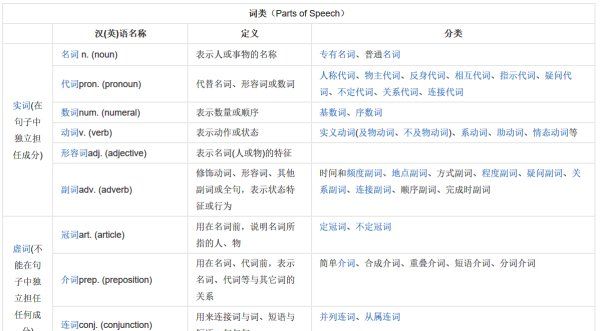
参考资料:百度百科-英语语法
五种基本句型100例句 :英语5种基本句型各50句
1.S(主) + Vi(不及物动词)(谓)
Time flies.
1) S + V + adverbial(状语)
Birds sing beautifully.
2) S + Vi+ prep Phrase(介词短语)
He went on holiday.
3) S + Vi+ Infinitive (不定式)
We stopped to have a rest.
4) S + Vi+ Participle (分词)
I'll go swimming.
2. S (主)+ Vt (及物动词)(谓)+ O(宾)
We like English.
1) S + VT + N/Pron
I like music.
I like her.
2) S + VT + infinitive(不定式)
I want to help him.
常用于这句型的动词有:attempt, dare, decide, desire, expect, hope, intend, learn, need, offer, pretend, promise, propose, purpose, refuse, want, wish等。
3) S + VT + Wh-Word + Infinitive
I don't know what to do.
常用于这句型的动词有:ask, consider, decide, discover, explain, find out, forget, guess, inquire, know, learn, observe, remember, see, settle, tell, think, understand, wonder等。
4) S + VT + Gerund
I enjoy living here.
常用于这句型的动词有:admit, advise, avoid, consider, defend, enjoy, excuse, finish, forbid, mind, miss, practise, risk, suggest, give up, can't help等。
5) S + VT + That-clause
I don't think (that) he is right.
常用于这句型的动词有:Admit, believe, command, confess, declare, demand, deny, doubt, expect, explain, feel(觉得), hear(听说), hope, imagine, intend, know, mean, mind(当心), notice, propose, request, report, say, see(看出),show, suggest, suppose, think, understand, wish, wonder(觉得奇怪)。
3. S (主)+ V(谓)(lv)( 系动词)+ P(表)
We are Chinese.
除了be 系动词外,还有一些动词也可以用作系动词,1)表感官的动词,feel, smell, taste, sound, look, appear, seem 等。2) 表转变变化的动词,become, get, grow, turn, go,等。 3)表延续的动词 remain, keep, seem, hold, stay, rest等。4)表瞬时的动词 come, fall, set, cut, occur等 5)其他动词 eat, lie, prove, ring, run, shine, sit, stand, continue, hang等。
1) S + Lv + N/Pron(名词/代词)
He is a boy.
This is mine.
2) S + Lv + Adj(形容词)
She is beautiful.
3) S + Lv + Adv (副词)
Class is over.
4) S + Lv + Prep Phrase
He is in good health.
5) S + Lv + Participle(分词)
He is excited.
The film is interesting.
4. S (主)+ VT (谓)+ In O(间接 宾) + D O(直接 宾)
I give you help.
1) S + VT + N/Pron + N
I sent him a book.
I bought May a book.
2) S + VT + N/Pron + To/for-phrase
He sent a book to me.
He bought a coat for me.
间接宾语前需要加to 的常用动词有:allow, bring, deny, do(带来), give, grant, hand, leave, lend, offer, owe, pass, pay, permit, promise, read, refuse, render, restore, sell, send, show, teach, tell wish, write等。
间接宾语前需要加for 的常用动词有:bring, buy, cash, choose, fetch, get, leave, make, order, paint, play(演奏),save, sing, spare等。
5. S (主)+ VT(谓)+ O(宾) + O C(宾补)
I make you clear.
1) S + VT + N/Pron + N
We named our baby Tom.
常用于这句型的动词有:appoint, call, choose, elect, entitle, find, make, name, nominate(命名)。
2) S + VT + N/Pron + Adj
He painted the wall white.
常用于这句型的动词有:beat, boil, cut, drive, find, get, hold, keep, leave, like, make, paint, see, set, turn, want, wash, wipe, wish等。
3) S + VT + N/Pron + Prep Phrase
She always keeps everything in good order.
4) S + VT + N/Pron + Infinitive
I wish you to stay.
I made him work
常用于这句型的动词有:a)不定式带to的词:advice, allow, ask, beg, cause, choose, command, decide, encourage, expect, force, get, hate, invite, know, leave, like, love, order, permit, persuade, prefer, remain, request, teach, tell, want, warn, wish等。b)不定式不带to的词:feel, have, hear, know, let, listen to, look at, make, notice, see, watch等。
5) S + VT + N/Pron + Participle (分词)
I heard my name called.
I feel something moving.
常用于这句型的动词有:catch, feel, find, get, have, hear, imagine, keep, leave, listen to, look at, notice, observe, perceive, see, set, smell, start, watch等。
6) S + VT + N/Pron + Wh-word + Infinitive
He show me how to do it.
常用于这句型的动词有:advise, ask, inform, show, teach, tell等。
7) S + VT + N/Pron + That-clause
He told me that the film was great.
常用于这句型的动词有:assure, inform, promise, remind, teach, tell, warm等。
8) S + VT + N/Pron + Wh-Clause
He asked me what he should do.
常用于这句型的动词有:Advise, ask, inform, show, teach, tell.
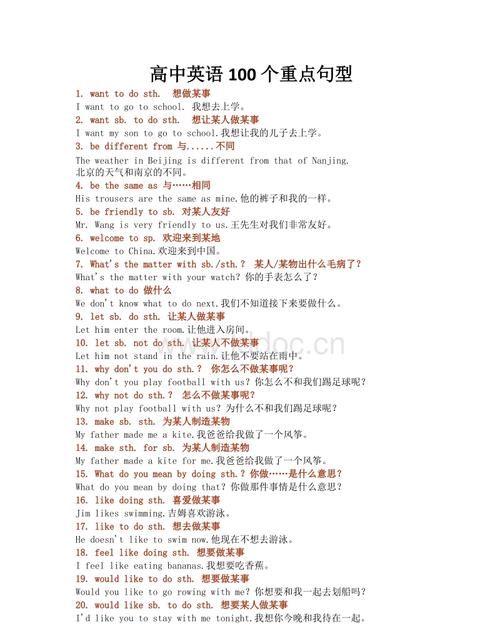
五种基本句型100例句 :英语的五种基本句型及例句
主----系-----表
These oranges have kept fresh
主----谓
Tom has left
主----谓-----宾
He kept the money
主---谓-间宾--直宾
He kept me a dictionary.
主---谓--宾--宾补
His illness left him weak
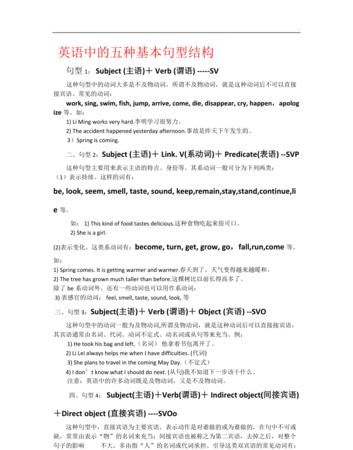
五种基本句型100例句 :五种基本句型
1. 主语+谓语 He cries.
2.主语+系动词+表语 She is happy.
3. 主语+谓语+宾语 She eats an apple.
4. 主语+宾语+宾语补足语 He made me angry.
5. 主语+间接宾语+直接宾语 I give him a bag.
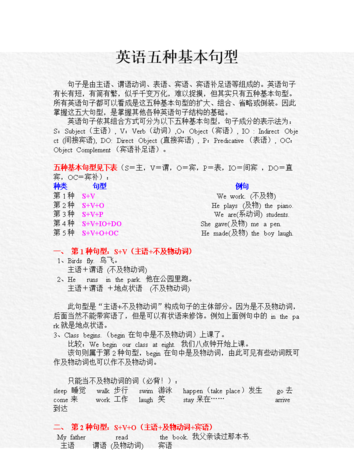
以上就是关于五种基本句型100例句 ,英语五种基本句型例句带翻译并指出对应的是什么的全部内容,以及五种基本句型100例句 的相关内容,希望能够帮到您。
